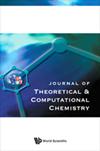The structural, spectral, frontier molecular orbital and thermodynamic analysis of 2-hydroxy 2-methyl propiophenone by MP2 and B3LYP methods
IF 2.4
Q3 Computer Science
Journal of Theoretical & Computational Chemistry
Pub Date : 2020-08-01
DOI:10.1142/s0219633620500200
引用次数: 1
Abstract
In the present work, we have studied the 2-hydroxy 2-methyl propiophenone (2H2MPP) theoretically as well as experimentally. The optimized molecular structure has been obtained by the density functional theory (DFT), second-order Moller–Plesset perturbation theory (MP2) and Hartree Fock (HF) in the gas phase as well as in different media like ethanol, DMSO and heptane. FT-IR and FT-Raman spectra were computed as well as recorded and fundamental vibrational wavenumbers were assigned. The electronic absorption spectra were calculated by employing the time-dependent density functional theory (TD-DFT) to get the information about excitation energies, oscillator strength and excited state geometries in gas phase and in different solvent media. Chemical activity and chemical stability obtained by HOMO-LUMO studies using a HF/6-31[Formula: see text]G and MP2/6-311[Formula: see text]G calculations. The chemical interpretation of hyperconjugation interactions obtained by the Natural Bond Orbital (NBO) analysis. Moreover, electrostatic potential (ESP) calculations performed to get the visual representation of relative polarity of molecule. Thermodynamic parameters like enthalpy, entropy, heat capacity, and Gibbs free energy computed with varying temperature from 10[Formula: see text]K to 500[Formula: see text]K. The aim of the current investigation is to find out the quantum chemical properties of the title compound which show an active role in the pharmaceutical and printing industries.用MP2和B3LYP方法对2-羟基2-甲基丙烯酮进行了结构、光谱、前沿分子轨道和热力学分析
本文对2-羟基-2-甲基丙苯(2H2MPP)进行了理论和实验研究。通过密度泛函理论(DFT)、二阶Moller–Plesset微扰理论(MP2)和Hartree-Fock(HF)在气相中以及在乙醇、二甲基亚砜和庚烷等不同介质中获得了优化的分子结构。计算并记录了FT-IR和FT-Raman光谱,并分配了基本振动波数。利用含时密度泛函理论(TD-DFT)计算了电子吸收光谱,得到了气相和不同溶剂介质中激发能、振子强度和激发态几何结构的信息。HOMO-LUMO研究使用HF/6-31[公式:见正文]G和MP2/6-311[公式:参见正文]G计算获得的化学活性和化学稳定性。通过自然键轨道(NBO)分析获得的超共轭相互作用的化学解释。此外,还进行了静电势(ESP)计算,以获得分子相对极性的可视化表示。热力学参数,如焓、熵、热容和吉布斯自由能,在10[公式:见正文]K至500[公式:参见正文]K的变化温度下计算。本研究的目的是找出标题化合物的量子化学性质,这些性质在制药和印刷工业中发挥着积极作用。
本文章由计算机程序翻译,如有差异,请以英文原文为准。
求助全文
约1分钟内获得全文
求助全文
来源期刊
CiteScore
1.70
自引率
0.00%
发文量
0
审稿时长
3 months
期刊介绍:
The Journal of Theoretical and Computational Chemistry (JTCC) is an international interdisciplinary journal aimed at providing comprehensive coverage on the latest developments and applications of research in the ever-expanding field of theoretical and computational chemistry.
JTCC publishes regular articles and reviews on new methodology, software, web server and database developments. The applications of existing theoretical and computational methods which produce significant new insights into important problems are also welcomed. Papers reporting joint computational and experimental investigations are encouraged. The journal will not consider manuscripts reporting straightforward calculations of the properties of molecules with existing software packages without addressing a significant scientific problem.
Areas covered by the journal include molecular dynamics, computer-aided molecular design, modeling effects of mutation on stability and dynamics of macromolecules, quantum mechanics, statistical mechanics and other related topics.

 求助内容:
求助内容: 应助结果提醒方式:
应助结果提醒方式:


